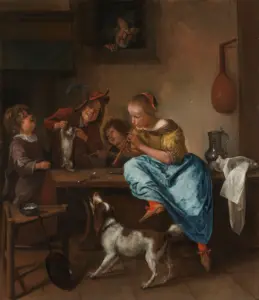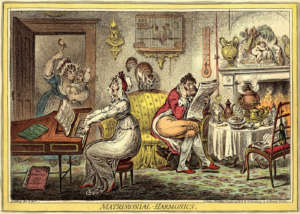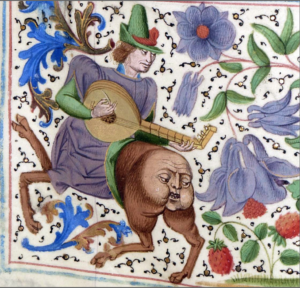Laughing your staves off: irony, satire, and parody in visual representations and narratives of music
23rd International Conference of
Association Répertoire International d’Iconographie Musicale
Universität für Musik und darstellende Kunst Wien
Vienna (Austria), 29–31 Aug 2024
From Zarathustra’s “holy” (Nietzsche, 1883–1885) over the Carnivalesque (Bakhtin, 1965) to Fools and Follies in Flemish Art (Silver, 2023) and Japanese traditional manzai, laughter and its manifold forms and cultural manifestations accompany nearly all facets of human emotions and their artistic representations. In visual depictions of music, the use of parody, irony, and satire serves as a vital tool not only for providing and stimulating laughter but also for conveying specific narratives, agendas, and critique.

Although they are commonly associated with humor as they often induce laughter, irony, satire, and parody are, same as laughter, not necessarily ‘humorous’. These ‘tools of laughter’ create powerful statements that resonate with audiences across times and cultures. Parody can be defined as a form of social criticism and as a catalyst, used to mock or satirize certain aspects within specific cultural matrixes (Babiskin, 1994), or as “a path to subvert and test dominant narratives and notions” (Hutcheon, 1989). Irony is a device to disrupt expectations and to challenge norms or beliefs and often allows for more nuanced and complex narratives (Brown, 1980).

Irony adds complexity, and in visual representations it can be a powerful tool for bringing attention to underlying issues, juxtaposing traditional ideas with progressive concepts, or making popular trends in culture and society (Gaut & Lopes, 2001). Satire is, finally, as Jonathan Swift reminded, “a sort of glass, wherein beholders do generally discover everybody’s face but their own.” It highlights society’s flaws while reflecting on oneself, and it is often used to convey a deeper meaning or message through unexpected or contradictory elements. Satire has long been used as a powerful tool for social and political commentary and criticism in various forms of media by entertainingly exposing societal issues and injustices, employing humor and exaggeration to criticize vices, follies, abuses, and shortcomings, and to convey a deeper meaning or message through unexpected or contradictory elements.

The 23rd International Conference of Association RIdIM will take place in Vienna (Austria) from 29 to 31 August 2024, hosted by the Universität für Musik und darstellende Kunst Wien (mdw). The main goal of the Conference is the exchange of knowledge about and reflection on irony, satire, and parody in visual representations and narratives of musical subject matters of all cultures and times.

Association RIdIM invites abstracts for individual papers of 20 minutes (+ 10 minutes discussion) in English. The submitted abstract and the subsequent conference paper must be original, not published or being considered for publication elsewhere. Full responsibility for both the abstract and the paper rests with the author, who must have taken the necessary steps to obtain permission to use any material that might be protected by copyright. Association RIdIM also very much welcomes proposals for themed panel sessions of 90 or 120 minutes (3 or 4 presentations) and round table sessions of 60 minutes.
The proposed topics include but are not limited to:
- Concepts of irony, satire, and parody in visual representations of music.
- The impact of irony, satire, and parody in visual representations of music and/or their production.
- Irony, satire, and parody in visual representations of music as tools for laughter.
- The role of gender, race, and class in the visualization of music with ironic, satiric, and parodic content or narrative.
- Laughter conveying specific narratives, agendas, and social and cultural criticism.
- Depictions and implications of laughter across visual representations of music.
Abstracts in English along with a short biography must be submitted by 12 April 2024, using the official RIdIM_Vienna 2024_Application_Form.
Applicants will be notified about the decision of the program committee by 1 May 2024.
There will be a registration fee of €uro 220 (standard) and €uro 100 (students).
Keynote Speakers
- Prof. Dr. Lydia Goehr, Columbia University (USA)
- Dr. Oksana Havryliv, University of Vienna (Austria)
Programme Committee
- Prof. Dr. Antonio Baldassarre, President Association RIdIM
- Dr. Carola Bebermeier, Universität für Musik und darstellende Kunst Wien (Austria)
- Dr. Zdravko Blažeković, Research Center for Music Iconography, City University of New York (U.S.A.)
- Prof. Dr. Daniela Castaldo, Università del Salento (Italy)
- Prof. Dr. Marita Fornaro Bordolli, Universidad de la República (Uruguay)
- Dr. Timur Sijaric, Hochschule Luzern – Musik (Switzerland)
- Dr. Arabella Teniswood-Harvey, University of Tasmania (Australia)
Figures
- Jan Havicksz. Steen, Children teaching a cat to dance (The Dancing Lesson), 1660-79, oil on panel, 68.5 x 59.0 cm. Amsterdam: Rijksmuseum (inv.-no. SK-A-718).
- Gillray, James. Matrimonial Harmonics, hand-colored etching. London: Hannah Humphries, 1805. Chicago: Art Institute (mus.-no.: 1928.719)
- Yahima Gakuti, Manzai, ca. 1820, woodcut, color, 21.0 x 18.8 cm.
- Monstrous musician, Froissart’s Chronicles, Bruges ca. 1470-1475. Paris: Bibliothèque national de France, Français 2643, fol. 72r
